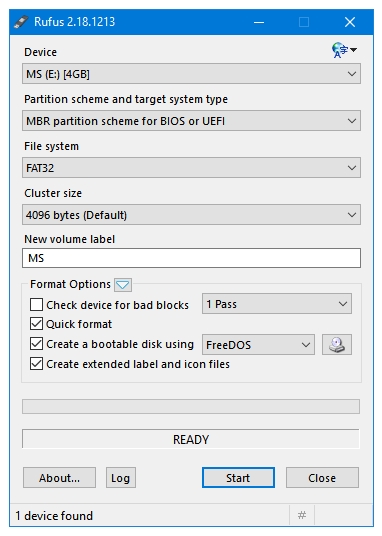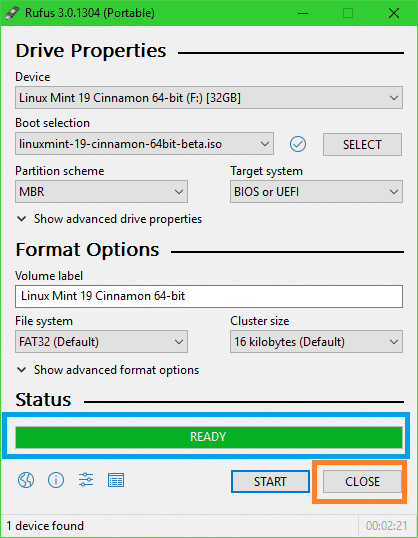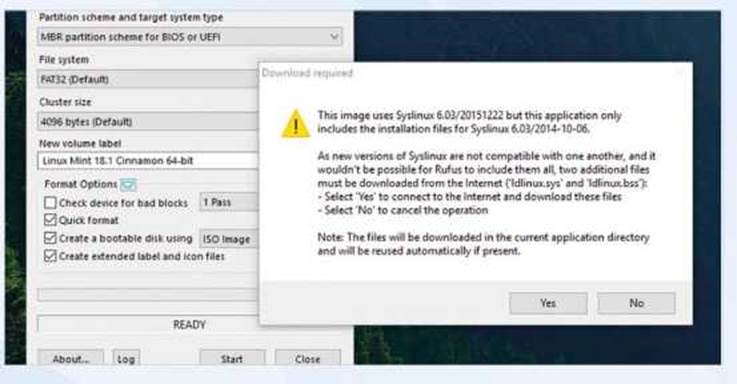

- RUFUS FOR LINUX MINT DOWNLOAD INSTALL
- RUFUS FOR LINUX MINT DOWNLOAD WINDOWS 10
- RUFUS FOR LINUX MINT DOWNLOAD ISO
How do I use UNetbootin from the command line? If it still isn't showing up, use the targetdrive command line option. Reformat the USB drive as FAT32, then use UNetbootin again. My USB stick/hard drive isn't detected, what should I do? Reformat the USB drive as FAT32, then use UNetbootin again to put your distribution on the USB stick. My USB stick isn't booting, what should I do?
RUFUS FOR LINUX MINT DOWNLOAD ISO
UNetbootin isn't able to download the distribution, what should I do?ĭownload the ISO straight from the website, then provide it to UNetbootin via the diskimage option. » Maybe, see Installing Other Distributions Using UNetbootin. FAQs Distribution X isn't on the list of supported distributions, will it work? Also, ISO files for non-Linux operating systems have a different boot mechanism, so don't expect them to work either. However, not all distributions support booting from USB, and some others require extra boot options or other modifications before they can boot from USB drives, so these ISO files will not work as-is. UNetbootin doesn't use distribution-specific rules for making your live USB drive, so most Linux ISO files should load correctly using this option. Installing Other Distributions Using UNetbootinĭownload and run UNetbootin, then select the "disk image" option and supply it with an ISO (CD image).

UNetbootin has built-in support for automatically downloading and loading the following distributions, though installing other distributions is also supported:
RUFUS FOR LINUX MINT DOWNLOAD INSTALL
If you used the "Hard Disk" install mode: After rebooting, select the UNetbootin entry from the Windows Boot Menu. On PCs, this usually involves pressing a button such as Esc or F12 immediately after you turn on your computer, while on Macs, you should hold the Option key before OSX boots. If you used the "USB Drive" install mode: After rebooting, boot from the USB drive. If your USB drive doesn't show up, reformat it as FAT32. Select an ISO file or a distribution to download, select a target drive (USB Drive or Hard Disk), then reboot once done. It loads distributions either by downloading a ISO (CD image) files for you, or by using an ISO file you've already downloaded.

UNetbootin can create a bootable Live USB drive You can either let UNetbootin download one of the many distributions supported out-of-the-box for you, or supply your own Linux. Once you followed the instructions, Click on “Start” to Initiate creating a bootable USB drive.UNetbootin allows you to create bootable Live USB drives for Ubuntu and other Linux distributions without burning a CD. Step 4: Click on Start to create a bootable device For standard bootable USB drive is not necessary to use.įor the sake of a simple guide, we will not touch any other options to avoid confusion. It helps you to store the changes which you have made in Live Boot. If you don’t know what is persistent partition size? Persistent partition size:- It is a new feature introduced in Rufus which users desperately missed. On the right side of the current screen, click on “Select” To specify the Downloaded ISO file location. You do not require to change default options “Disk or ISO image” unless and until you have a different Objective. In case of multiple USB drives, select the USB drive that you want to use for Bootable from the drop-down menu.īoot selection:- This is a step where you need to provide the ISO file location for which you want to create a bootable device. In Windows, one of the best tools to create a bootable Disk is Rufus.ĭevice:- Over here, you will see the connected USB device name along with USB disk size. It is a piece of cake to create a bootable drive using the Rufus tool. I’m not saying other utilities are not open-source, but what I love about a Rufus is the size just (1.1 MB) compared to other Utility tools, and you do not need to install too, isn’t that amazing, Just Download and Run. Who doesn’t love the Opensource project, aren’t you? Rufus is an open-source application that allows you to create a Bootable USB drive in a Simple Step. In Linux, we have multiple Utility tools to create bootable thumb drives, such as balenaEtcher, Ventoy, and my personal favorite dd command.įor windows, we still have options to use the above application.

The foremost part is to have a bootable USB drive to perform the installation process.
RUFUS FOR LINUX MINT DOWNLOAD WINDOWS 10
When you have decided to switch from Windows 10 to Linux Distributions like Ubuntu, Linux Mint, Pop-OS, or any other Distribution’s.ġ0 Reasons Why You Should Switch From Windows To Linux


 0 kommentar(er)
0 kommentar(er)
